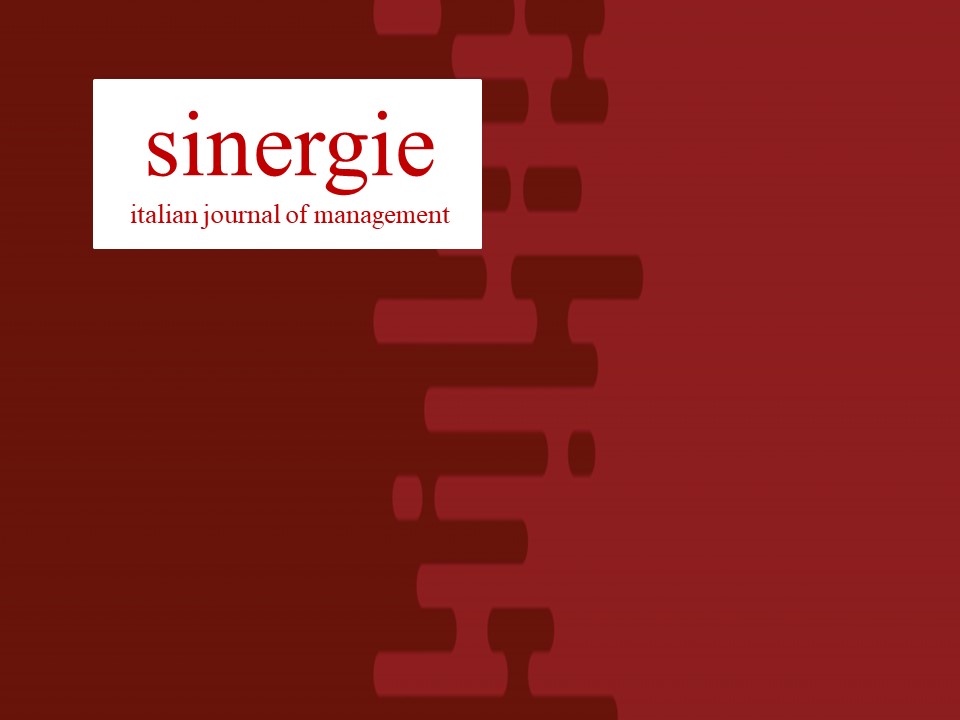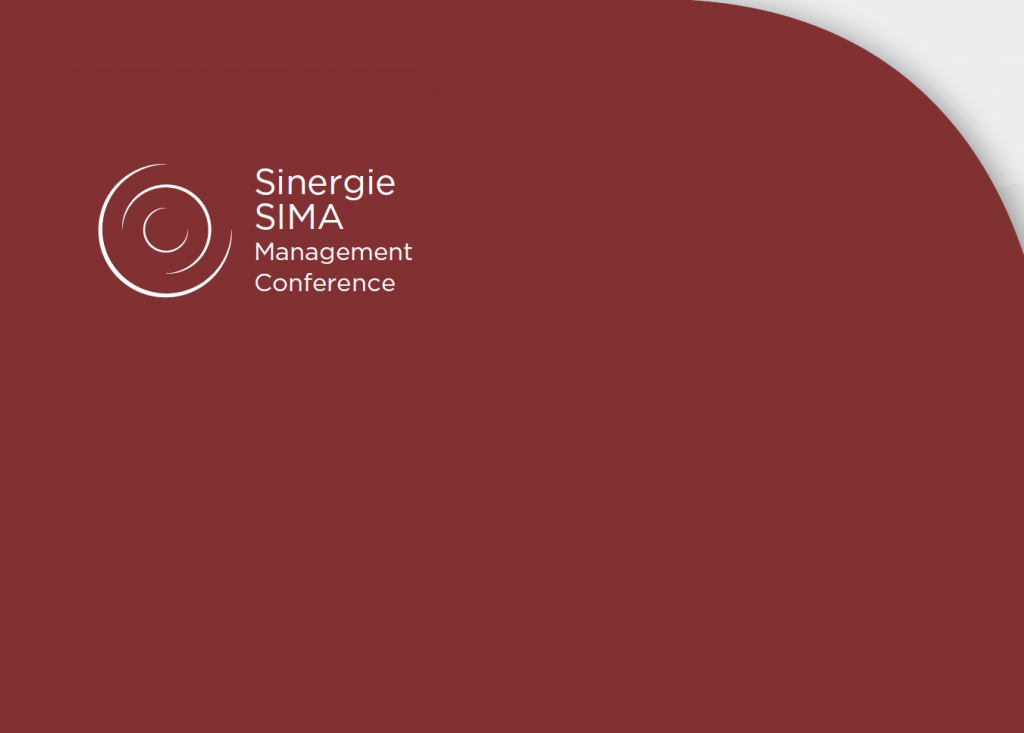Negoziabilità del profitto e design organizzativo: una proposta interpretativa
Obiettivo del paper: Proporre un modello teorico-concettuale in grado di giustificare teoricamente la qualificazione del profitto come rendita negoziabile ex ante tra propriete top management e di chiarirne le implicazioni per il design organizzativo.
Metodologia: Revisione ed integrazione di piframework teorici: la letteratura inerente la negoziazione ex ante sulla rendita; i contributi sul design organizzativo.
Risultati: Secondo il modello proposto, le organizzazioni in cui il profitto trattato come rendita negoziabile ex ante tra propriete top management tendono ad essere caratterizzate da bassa formalizzazione e moderati livelli di centralizzazione e specializzazione, ossia da strutture organizzative che approssimano il modello quasi-organicistico.
Limiti della ricerca: Lo studio avanza proposizioni teorico-concettuali, non corredate da validazione empirica.
Implicazioni pratiche: La prima implicazione concerne leventualitche taluni stakeholder, sia interni sia esterni allimpresa, negoziando ex ante sulla propria rendita, possano influenzare lammontare del valore totale appropriato dallimpresa. Un secondo profilo di riflessione emerge con riguardo alleventualitche la quasi-coalizione tra propriete management possa propendere verso la progettazione di strutture organizzative in grado di rafforzarne il relativo potere negoziale, ancorchinappropriate alla luce delle condizioni di contesto e delle probabilitdi sopravvivenza dellimpresa. Piin generale, il modello proposto stimola la riflessione sui rapporti tra negoziabilitdel profitto, strutture organizzative e relativa idoneita favorire lo sviluppo di nuove capacit noncha ricomporre il conflitto di interessi tra propriete management.
Originalitdel paper: Lo studio si situa allintersezione tra diverse prospettive teoriche, invertendo il nesso di causalittra profitto e design organizzativo e arricchendo il dibattito sulle fonti di eterogeneitdelle imprese e dei relativi modelli organizzativi.
Riferimenti bibliografici
ALVAREZ S.A. (2007), Entrepreneurial rents and the theory of the firm, Journal of Business Venturing, vol. 22, n. 3, pp. 427-442.
ASTLEY W.G., VAN DE VEN A.H. (1983), Central perspectives and debates in organization theory, Administrative Science Quarterly, vol. 28, n. 2, pp. 245-273.
ASTLEY W.G., ZAJAC E.J. (1991), Intraorganizational power and organizational design: reconciling rational and coalitional models of organization, Organization Science, vol. 2, n. 4, pp. 399-411.
BANTEL K.A. (1993), Top team, environment, and performance effects on strategic planning formality, Group & Organization Management, vol. 18, n. 4, pp. 436-458.
BELUSSI F., PILOTTI L. (2006), Eterogeneit delle imprese e variet dei modelli organizzativi, in Cainelli G., De Liso N. (a cura di), Organizzazioni, conoscenze e sistemi locali, Franco Angeli, Milano.
BLAU P.M. (1970), A formal theory of differentiation in organizations, American Sociological Review, vol. 35, n. 2, pp. 201-218.
BLYLER M., COFF R.W. (2003), Dynamic capabilities, social capital, and rent appropriation: ties that split pies, Strategic Management Journal, vol. 24, n. 7, pp. 677-686.
BOWMAN C., AMBROSINI V. (2000), Value creation versus value capture: towards a coherent definition of value in strategy, British Journal of Management, vol. 11, n. 1, pp. 115.
BURNS T., STALKER G.M. (1961), The management of innovation, University of Illinois at Urbana-Champaigns Academy for Entrepreneurial Leadership, Historical Research Reference in Entrepreneurship.
CAMPBELL B.A., COFF R., KRYSCYNSKI D. (2012). Rethinking sustained competitive advantage from human capital, Academy of Management Review, vol. 37, pp. 376-395.
CASTANIAS R.P., HELFAT C.E. (2001), The managerial rents model: Theory and empirical analysis, Journal of Management, vol. 27, n. 6, pp. 661-678.
CHACAR A., COFF R. (2000), The knowledge-based employees paradox. Winning Strategies in a Deconstructing World, John Wiley & Sons Ltd, London.
CHAKRAVARTHY B.S. (1982), Adaptation: A promising metaphor for strategic management, Academy of Management Review, vol. 7, n. 1, pp. 35-44.
CHANDLER A.D. (1962), Strategy and structure: Chapters in the history of the American enterprise, Massachusetts Institute of Technology, Cambridge.
CHILD J. (1972), Organizational structure, environment and performance: The role of strategic choice, Sociology, vol. 6, n. 1, pp. 1-22.
COFF R.W. (1999), When competitive advantage doesnt lead to performance: The resource-based view and stakeholder bargaining power, Organization Science, vol. 10, n. 2, pp. 119-133.
COFF R.W. (2003), Bidding wars over R&D-intensive firms: Knowledge, opportunism, and the market for corporate control, Academy of Management Journal, vol. 46, n. 1, pp. 74-85.
COFF R.W. (2010), The coevolution of rent appropriation and capability development, Strategic Management Journal, vol. 31, n. 7, pp. 711-733.
COFF R.W., LEE P.M. (2002), Insider trading as a vehicle to appropriate rent from R&D, Strategic Management Journal, vol. 24, n. 2, pp. 183-190.
COVIN J.G., SLEVIN D.P. (2006), Strategic management of small firms in hostile and benign environments, Strategic Management Journal, vol. 10, n. 1, pp. 75-87.
CYERT R.M., MARCH J.G. (1963), A behavioral theory of the firm, Prentice Hall, Englewood Cliffs.
DAVID P., OBRIEN J.P., YOSHIKAWA T., DELIOS A. (2010), Do shareholders or stakeholders appropriate the rents from corporate diversification? The influence of ownership structure, Academy of Management Journal, vol. 53, n. 3, pp. 636-654.
DIERICKX I., COOL K. (1989), Asset stock accumulation and sustainability of competitive advantage, Management Science, vol. 35, n. 12, pp. 1504-1511.
DONALDSON L., DAVIS J.H. (1991), Stewardship theory or agency theory: CEO governance and shareholder returns, Australian Journal of Management, vol. 16, n. 1, pp. 49-64.
GALBRAITH JR. (1973), Designing complex organizations, Addison-Wesley Longman Publishing Co., Inc., Boston.
GATTI M., BIFERALI D., VOLPE L. (2009), Il governo dellimpresa tra profitto e creazione di valore, Sinergie, n. 79, pp. 145-179.
GOFFEE R. (1996), Understanding family businesses: issues for further research, International Journal of Entrepreneurial Behaviour & Research, vol. 2, n. 1, pp. 36-48.
GOFFEE R., SCASE R. (1985), Proprietorial control in family firms: Some functions of quasi-organic management systems, Journal of Management Studies, vol. 22, n. 1, pp. 53-68.
GOLINELLI G.M. (2011), LApproccio Sistemico Vitale (ASV) al Governo dellImpresa, Cedam, Padova.
GOLINELLI G.M., PROIETTI L., VAGNANI G. (2008), Lazione di governo tra competitivit e consonanza, in GOLINELLI G.M. (2008), LApproccio Sistemico al Governo dellimpresa. Verso la Scientificazione dellAzione di Governo, Cedam, Padova.
GOLINELLI G.M., VOLPE L. (2012), Consonanza, Valore, Sostenibilit. Verso lImpresa Sostenibile, Cedam, Padova.
HATCH N.W., DYER J.H. (2004), Human capital and learning as a source of sustainable competitive advantage, Strategic Management Journal, vol. 25, pp. 1155-1178.
HIRSCH P.M. (1975), Organizational effectiveness and the institutional environment, Administrative Science Quarterly, vol. 20, n. 3, pp. 327-344.
JENSEN M.C., MECKLING W.H. (1976), Theory of the firm: Managerial behavior, agency costs and ownership structure, Journal of Financial Economics, vol. 3, n. 4, pp. 305-360.
JOHNSON S. (2000), Tunneling, American Economic Review, vol. 90, n. 2, pp. 22-27.
KAST F.E., ROSENZWEIG J.E. (1973), Contingency views of organization and management, Sra, Chicago.
KHANDWALLA P.N. (1972), Environment and its impact on the organization, International Studies of Management & Organization, vol. 2, n. 3, pp. 297-313.
KHANDWALLA P.N. (1977), The design of organizations, Harcourt Brace Jovanovich, New York.
KIRZNER I.M. (1973), Competition and Entrepreneurship, University of Chicago Press, Chicago.
KIRZNER I.M. (1979), Perception, Opportunity and Profit: Studies in the Theory of Entrepreneurship, University of Chicago Press, Chicago.
KLEIN B., CRAWFORD R.G., ALCHIAN A.A. (1978), Vertical integration, appropriable rents, and the competitive contracting process, Journal of Law and Economics, vol. 21, n. 2, pp. 297-326.
KOR Y.Y., LEBLEBICI H. (2005), How do interdependencies among human-capital deployment, development, and diversification strategies affect firms financial performance? , Strategic Management Journal, vol. 26, pp. 967-985.
LAWRENCE P.R., LORSCH J.W. (1967), Differentiation and integration in complex organizations, Administrative Science Quarterly, vol. 12, n. 1, pp. 1-47.
LAWRENCE P.R., LORSCH J.W. (1986), Organization and Environment: Managing Differentiation and Integration, Harvard Business School Classics.
MARSDEN P.V., COOK C.R., KALLEBERG A.L. (1994), Organizational Structures Coordination and Control, American Behavioral Scientist, vol. 37, n. 7, pp. 911-929.
MILGROM P., ROBERTS J. (1992), Economics, organization and management, Prentice Hall, Englewood Cliffs, (ed. italiana, Economia, organizzazione e management, Il Mulino, Bologna, 1994).
MINTZBERG H. (1979), The structuring of organizations: A synthesis of the research, University of Illinois at Urbana-Champaigns Academy for Entrepreneurial Leadership Historical Research Reference in Entrepreneurship.
MORAN P., SIMONI M., VAGNANI G. (2011), Becoming the best: by beating or ignoring the best? Toward an expanded view of the role of managerial selection in complex and turbulent environments, Journal of Management and Governance, vol. 15, n. 3, pp. 447-481.
MORCK R., YEUNG B. (2004), Family control and the rent?seeking society, Entrepreneurship Theory and Practice vol. 28, n. 4, pp. 391-409.
NAPOLEONI C. (1956), Dizionario di economia politica, Edizioni di Comunita?, Torino.
PERROW C. (1967), A framework for the comparative analysis of organizations, American Sociological Review, vol. 32, n. 2, pp. 194-208.
PERROW C. (1970), Organizational analysis: a sociological view, Wadsworth, Belmont.
PERROW C. (1985), Review essay: Overboard with mith and symbols, American Journal of Sociology, vol. 91, n.1, pp. 151-155.
PETERAF M.A. (1993), The cornerstones of competitive advantage: a resource-based view, Strategic Management Journal, vol. 14, n. 3, pp. 179-191.
PFEFFER J., SALANCIK G.R. (1977), Organization design: The case for a coalitional model of organizations, Organizational Dynamics, vol. 6, n. 2, pp. 15-29.
PFEFFER J., SALANCIK G.R. (1978), The external control of organisations, Stanford Business Classics, Stanford.
PUGH D.S., HICKSON D.J., HININGS C.R., TURNER C. (1969), The context of organization structures, Administrative Science Quarterly, vol. 14, n. 1, pp. 91-114.
RIVKIN J.W., SIGGELKOW N. (2003), Balancing search and stability: Interdependencies among elements of organizational design, Management Science, vol. 49, n. 3, pp. 290-311.
SCOTT W.R., MEYER J.W. (1983), The organization of societal sectors, in Meyer J.W., Scott W.R. (a cura di), Organizational Environments: Ritual and Rationality, Sage, New York, pp. 129-153.
SCHUMPETER J.A. (1934), The theory of economic development, Harvard University Press, Cambridge (MA).
SIGGELKOW N. (2002), Evolution toward fit, Administrative Science Quarterly, vol. 47, n. 1, pp. 125-159.
SIGGELKOW N., RIVKIN J.W. (2005), Speed and search: Designing organizations for turbulence and complexity, Organization Science, vol. 16, n. 2, pp. 101-122.
SMITH A. (1937), The Wealth of Nations (1776), Modern Library, New York.
TEECE D.J. (1986), Profiting from technological innovation: Implications for integration, collaboration, licensing and public policy, Research Policy, vol. 15, n. 6, pp. 285-305.
THOMPSON J.D. (1967), Organizations in action, McGraw-Hill, New York.
VAGNANI G., VOLPE L. (2009), Struttura formale, informale e prestazioni individuali, Sviluppo & Organizzazione, vol. 234, pp. 18-36.
WANG H.C., HE J., MAHONEY J. (2009), Firm-specific knowledge resources and competitive advantage: The roles of economic- and relationship-based employee governance mechanisms, Strategic Management Journal, vol. 30, n. 12, pp. 1265-1285.
WOODWARD J., DAWSON S., WEDDERBURN D. (1965), Industrial organization: Theory and practice, Oxford University Press, London.
WRIGHT P.M., COFF R., MOLITERNO T.P. (2013), Strategic Human Capital Crossing the Great Divide, Journal of Management, in corso di pubblicazione, doi: 0149206313518437.
ZUCKER L.G. (1987), Institutional theories of organization, Annual Review of Sociology, vol. 13, n. 1, pp. 443-464.


